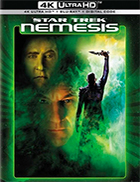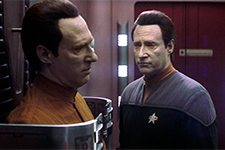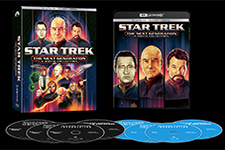| Director: Stuart Baird | | Screenplay: John Logan (story by John Logan & Rick Berman & Brent Spiner; based on Star Trek created by Gene Roddenberry) | | Stars: Patrick Stewart (Cpt. Jean-Luc Picard), Jonathan Frakes (William T. Riker), Brent Spiner (Data), LeVar Burton (Geordi La Forge), Michael Dorn (Worf), Gates McFadden (Dr. Beverly Crusher), Marina Sirtis (Deanna Troi), Tom Hardy (Praetor Shinzon), Ron Perlman (Reman Viceroy), Dina Meyer (Donatra) | | MPAA Rating: PG-13 | | Year of Release: 2002 | | Country: U.S. |  |
|  Star Trek: Nemesis marked the tenth time the Starship Enterprise had “boldly gone where no man has gone before” on the big screen. It had been four years since the last installment, the poorly received Star Trek: Insurrection (1998), and, if anything, Nemesis was a sure sign that the producers behind the franchise were searching for a way to reinvent it. Darker, edgier, more violent, and loaded with all manner of subtext (not to mention sex), Nemesis is definitely something different, even if it doesn’t quite live up to the filmmakers’ obviously grandiose ideas and ultimately embraces the idealistic humanism that has always been at Star Trek’s core. Much like the best film in the series, Star Trek II: The Wrath of the Khan (1982), Nemesis, as the title suggests, is built largely around the villain, in this case a former slave named Shinzon (a young Tom Hardy) who is also a youthful clone of the Enterprise’s hero, Captain Jean-Luc Picard (Patrick Stewart). The film might have been more appropriately titled Star Trek: Duality, as not only do we have the Picard/Shinzon split, one good, one evil, but the crew also discovers a slightly less-advanced twin of the android Data (Brent Spiner). Although it is eventually revealed that this twin has a nefarious purpose, the film generates some of its most moving moments between the two androids, as Data, who constantly aspires to be as human as possible, tries to explain the world to his android twin, whose lack of understanding is poignantly wrought. The vast majority of the story takes place during an elaborate and extended space battle between the Enterprise and Shinzon’s highly advanced ship that features a nearly undetectable cloaking device and has much stronger shields and weapons. Star Trek is always best when its heroes are at a disadvantage, and here Picard and company are definitely the underdogs, fighting off Shinzon’s attacks while also trying to thwart his plans to disrupt an ongoing peace process between the Federation and the Romulans by destroying the Earth. This is all on the grand scale, but screenwriter John Logan (Gladiator) also maintains a focus on the personal, as Shinzon has a personal vendetta against Picard and also needs the captain for his blood, which is the only thing that can save him from the rapid degeneration of his own body. Director Stuart Baird had worked primarily as an editor since the early 1970s, collaborating with such diverse filmmakers as Ken Russell and Richard Donner, and he dabbled briefly in directing in the late 1990s with Executive Decision (1996) and The Fugitive sequel U.S. Marshalls (1998) (Star Trek: Nemesis was his last time behind the camera). Given his extensive experience editing action sequences in films such as Lethal Weapon (1987) and Die Hard 2 (1990), it is not surprising that Baird stages the intergalactic battle sequences with as much flair as the genre will allow, although it is sometimes hard to ignore the tiredness of reports about deflector shields being at 50%. The ships are so large and slow-moving that it is sometimes difficult to build up a great deal of excitement watching them blast away at each other with only minimal damage. These situations are such a part of the series that we might feel lost without them, but one wonders if a Star Trek film might ever feature smaller and quicker ships. As it stands right now, it is like watching a dogfight between aircraft carriers. Much better is a Mad Max-esque chase sequence on a scorched desert planet that stands out visually from the rest of the film. This is not to say that Nemesis does not have its strong points. Cinematographer Jeffrey L. Kimball gives the film some powerful visuals, something that is often missing in Star Trek movies. Granted, this generally means that everything is just darker and much more shadowy, but given the film’s darker tone and its related thematic material, this visual approach is entirely appropriate and works well. Shinzon’s ship is particularly well-rendered, and he is costumed in an outrageous black, shiny leather get-up with exaggerated shoulders that emphasize his oversized ego. While he doesn’t come close to the operatic evil of Ricardo Montalban’s Khan, Tom Hardy does a fine job of evoking Shinzon’s deep-seated anger, playing him like an angry child with weapons of mass destruction at his fingertips. Having Shinzon be a genetic replicate of Picard was a good idea, but it was even better to make him a younger version. Thus, it is not so much Picard battling himself as it is the elder, wiser Picard battling his younger, more arrogant self. At several points in the film, it is brought up that Picard could have just as easily turned into Shinzon had he lived his life, which is an interesting means of complicating the captain’s otherwise unquestioned heroism and dignity. Did Picard turn out to be a great man simply because he was born great, or was it because he just happened to be in the right circumstances? And, inversely, was Shinzon just born evil, or was he molded to be evil? On an even more challenging level, the film asks us whether the very characteristics that define goodness, when slightly twisted, are the same characteristics that define evil. | Star Trek: The Next Generation Four-Movie 4K UHD + Blu-ray + Digital Copy Box Set |  Star Trek: Nemesis is available both individually and as part of the eight-disc “Star Trek: The Next Generation” box set, which includes both 4K UHD discs and Blu-rays, as well as Digital Copies. Star Trek: Nemesis is available both individually and as part of the eight-disc “Star Trek: The Next Generation” box set, which includes both 4K UHD discs and Blu-rays, as well as Digital Copies. | | Aspect Ratio | 2.35:1 (all four films) | | Audio | English Dolby TrueHD 5.1 surround (all four films) | | Subtitles | English, French, Spanish (all four films) | | Supplements | Star Trek: GenerationsAudio commentary by director David Carson and Manny CotoAudio commentary by Brannon Braga and Ronald D. MooreText Commentary by Michael and Denise OkudaLibrary Computer“Uniting Two Legends” “Stellar Cartography: Creating the Illusion” “Strange New Worlds: The Valley of Fire” “Scoring Trek” “Inside ILM: Models & Miniatures” “Crashing the Enterprise” Scene Deconstruction: Main Title SequenceScene Deconstruction: The Nexus RibbonScene Deconstruction: Saucer Crash Sequence“A Tribute to Matt Jeffries” “The Enterprise Lineage” “Captain Picard’s Family Album” “Creating 24th Century Weapons” “Next Generation Designer Flashback Andrew Probert” “Stellar Cartography on Earth” “Brent Spiner: Data and Beyond Part 1” “Trek Roundtable: Generations” “Starfleet Academy SCISEC Brief 007: Trilithium” Deleted scenesArchivesTrailers Star Trek: First Contact Audio commentary by director and actor Jonathan FrakesAudio commentary by screenplay writers Brannon Braga and Ronald D. MooreAudio commentary by Damon Lindelof and Anthony PascaleText commentary by Michael and Denise OkudaLibrary Computer“Making First Contact”“The Art of First Contact”“The Story”“The Missile Silo”“The Deflector Dish”“From ‘A’ to ‘E’”Scene Deconstruction: Borg Queen AssemblyScene Deconstruction: Escape Pod LaunchScene Deconstruction: Borg Queen’s Demise“Jerry Goldsmith: A Tribute”“The Legacy of Zefram Cochrane”“First Contact: The Possibilities”“Industrial Light & Magic: The Next Generation”“Greetings from the International Space Station”“SpaceShipOne’s Historic Flight”“Brent Spiner: Data and Beyond Part 2”“Trek Roundtable: First Contact”“Starfleet Academy SCISEC Brief 008: Temporal Vortex”“Unimatrix One”“The Queen”“Design Matrix”ArchivesTrailers Star Trek: Insurrection Audio commentary by Jonathan Frakes and Marina SirtisText Commentary by Michael and Denise OkudaLibrary Computer“It Takes a Village”“Location, Location, Location”“The Art of Insurrection”“Anatomy of a Stunt”“Making Star Trek: Insurrection”“Director’s Notebook”“The Star Trek Universe”“Westmore’s Aliens”“Westmore’s Legacy”“Star Trek’s Beautiful Alien Women”“Marina Sirtis - The Counselor Is In”“Brent Spiner - Data and Beyond Part 3”“Trek Roundtable: Insurrection”“Starfleet Academy SCISEC Brief 009: The Origins of the Ba’ku and Son’a Conflict”“Shuttle Chase”“Drones”“Duck Blind”Deleted ScenesArchivesAdvertisingStar Trek: Nemesis Audio commentary by director Stuart BairdAudio commentary by producer Rick BermanAudio commentary by Michael and Denise OkudaText Commentary by Michael and Denise OkudaLibrary Computer“Nemesis Revisited” “New Frontiers – Stuart Baird on Directing Nemesis” “Storyboarding the Action” “Red Alert! Shotting the Action of Nemesis” “Build and Rebuild” “Four-Wheeling in the Final Frontier” “Screen Test: Shinzon” “A Star Trek Family’s Final Journey” “A Bold Vision of The Final Frontier” “The Enterprise E” “Reunion with The Rikers” “Today’s Tech Tomorrow’s Data” “Robot Hall of Fame” “Brent Spiner - Data and Beyond Part 4” “Trek Roundtable: Nemesis” “Starfleet Academy SCISEC Brief 010: Thalaron Radiation” “Romulan Lore” “Shinzon & the Viceroy” “The Romulan Senate” “The Scimitar” Deleted ScenesArchivesTrailers | | Distributor | Paramount Home Entertainment | | Release Date | April 4, 2023 | | | COMMENTS | | All four films in Paramount’s Star Trek: The Next Generation 4-Movie Collection have been given new 4K scans from the 35mm camera negatives and look demonstrably better than the 2009 Blu-rays they are replacing. Obviously, the 2160p Dolby Vision/HDR10 transfers offer substantially enhanced visual information and better detail. Colors are also greatly improved, with a wider color range and much better saturation. What I noticed, however, was that the films look much more cinematic. The 2009 Blu-rays had quite a bit of digital noise reduction and artificial sharpening that took away from their celluloid origins. These new 4K UHD discs display a much more natural looking image that features fine grain and a more filmlike appearance that is much more in keeping with their original theatrical presentations. Each film features a remastered Dolby TrueHD 7.1-channel soundtrack, which again improves on the 5.1-channel mixes on the earlier Blu-rays. There isn’t a ton of difference, although astute ears will certainly detect more dynamic directionality, improved sonic detail, and an all-around more immersive aural experience. As for the supplements, there is nothing new here. Everything that appeared on the earlier Blu-rays is accounted for here, as the set includes a Blu-ray disc for each film that includes both the remastered film and all the supplements (aside from the commentaries, which are also included on the 4K discs). I won’t go through it all here, as the range of supplements is both deep and wide, encompassing multiple audio commentaries, text commentaries, behind-the-scenes featurettes, screen tests, special effects reels, and more. |
Copyright © 2023 James Kendrick Thoughts? E-mail James Kendrick All images copyright © Paramount Home Entertainment |



 (3)
(3)

 Star Trek: Nemesis is available both individually and as part of the eight-disc “Star Trek: The Next Generation” box set, which includes both 4K UHD discs and Blu-rays, as well as Digital Copies.
Star Trek: Nemesis is available both individually and as part of the eight-disc “Star Trek: The Next Generation” box set, which includes both 4K UHD discs and Blu-rays, as well as Digital Copies.